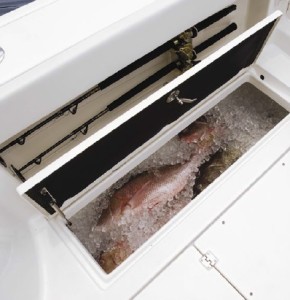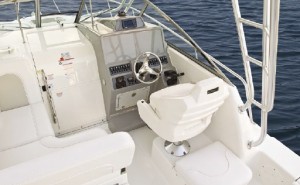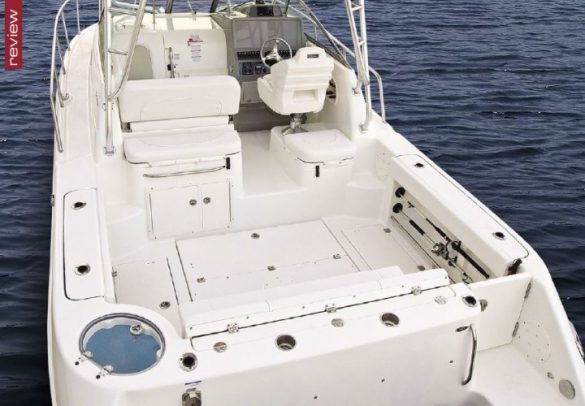Going aboard the Robalo R305 you are straightaway drawn to some very distinguishing features, such as the Pullman style forward berth that sees the forward settee easily convert to a berth by lowering the table and adding filler cushions. The seatbacks also flip up to form Pullman style berths allowing four to sleep in this area, creating an example of creative use of space.
Then there is the cockpit bench seating. While we’ve seen aft bench seats that fold up flush against the transom before, this one seems to have a more functional take on the design. It deploys and stores easier than most and the entire assembly lifts to reveal storage in the transom for batteries, battery switches and charger.
Overhead, the standard hardtop includes an electronics box, fore and aft spreader lights and drop down life jacket storage. Dual live wells are also a very slick idea with a 94.6 litre and the other an 113.5 litre at opposing corners of the cockpit. I also liked the multi function helm deck seat that converts between forward facing, aft facing and flat chaise. Overall, the designers have put a huge amount of thought in the layout and the functionality of the R305 and made some interesting design decisions that work very well.
Performance & Handling
The Robalo R305 has a length overall of 8.89 m, a beam of 3.2 m and a draft of 81 cm. With an empty weight of 4354 kg, 379 litres of fuel and three people on board we had a test weight of 4,901 kg.
With a pair of 300-hp Yamaha 4-strokes powering our test boat we reached a top speed at 5900 rpm of 52.8 mph. At that speed fuel burn was 196 lph giving us a range of 275 miles. Best cruise came in at 3500 rpm and 28.8 mph. That reduced the fuel burn to 64 lph that the R305 could keep up for 16 hours and 460 miles while still maintaining a 10% reserve.
When accelerating the R305 her bow comes up 16-degrees that causes a brief loss of visibility to the horizon. Once underway she settles into a 7.5-degree bow high attitude and it only takes a couple of shots of up trim to get her into the cruising attitude. When turning, the R305 leans 12 1/2-degrees into the turn that I found comfortable. When taking power on she settles back into the water at a level attitude.
Walkthrough Stern
Dual swim platforms measuring flank the engine well, where you find the engines spaced 27.9 cm apart but still offered sufficient torque for low-speed maneuvering around the dock without the optional bow thruster. To starboard, a post-type reboarding ladder recesses into the hull and a hot/cold shower is found in the starboard bulwarks.
The R305 cockpit is roomy and features the bulk of the fishing amenities. Two rod holders flank either end of the transom cap rail and the 94.6 litre livewell with nine inlets for circulation, LED lighting and a blue gel coated oval interior is recessed into the port quarter. An aft bench seat measuring 1.4 m folds up conveniently into the transom to really open up the cockpit space for fishing.


I also found it easy to deploy simply by lifting the bolster and pulling the seat down. The entire seating arrangement lifts to reveal storage within the transom for the batteries, battery switch panel and charger. Twin 375 litre in-deck fish boxes lie to port and starboard of the cockpit and forward is a hatch leading to a pump room that also accommodates the optional 3 kW gas generator.
Hardtop Protection
At the forward end of the cockpit we have a bench seat to port and a jump seat to starboard. The port station doubles as a rigging station with a sink and cutting board above lockable storage for tackle boxes and pullout drawers. Under the starboard seat is a second live well, this time with a 113.6 litre capacity.
Robalo went with a standard hardtop on the R305, but on our test boat the top included the optional rocket launchers and outriggers. Additional standard equipment with the hardtop include fore and aft facing spreader lights, courtesy lights, a covered electronics box and the life jacket storage compartment.
Stepping up to the helm deck we have L-shaped seating to port with a seat back that converts from forward facing to aft facing and then lays flat to allow a rear facing chaise lounge with an unobstructed view to the cockpit.

The helm console is coloured gray to knock down glare from any light that makes its way past the hardtop. A wide-open panel will accommodate the optional 12” display and radar options are offered in either a closed array or an open array version. Twin Garmin MFDs are available on the option list. A separate module was added to the top of the console for the Yamaha multifunction display and while it appears that there is room on the panel for this display, the addition on top of the console didn’t seem to impede my visibility at all.
Below the panel a row of rocker switches, with circuit breakers underneath, flank both sides of the stainless three spoke steering wheel mounted to a tilt base. A single key ignition activates the dual start/stop buttons just above and the controls to starboard are mounted at a 45-degree angle.
The helm seat has a high wraparound for security and thickly padded lumbar support over a ventilated lower back. The seat has extra thick padding and the controls for the swivel and slide are in plain sight and clearly labeled. More importantly the seat will allow the skipper to swivel his body around without having to swivel the seat itself.

The bow is accessed from side decks, which is convenient as it also facilitates line handling. Rail height comes up 47 cm at the windshield and increases to 56 cm at the working end of the bow. Fully forward is a recessed standard windlass with the anchor chute running through a recessed space between the caprails. The polished stainless steel anchor on our test boat was optional.
Should the R305 take any water over the bow, the side decks are moulded in such a way that it gets directed right back overboard. Any water that does manage to make its way into the cockpit will get directed overboard through drains in both quarters.
Below Decks

The below decks area will easily accommodate overnighting for up to six people. A teak and holly laminate flooring is standard. As we make our way down the open-tread teak stairway, the head is located immediately to starboard and is fully fiberglass lined. It features 1.75m of overhead clearance and a VacuFlush porcelain marine head, plumbed to a 45.4 litre holding tank, comes standard.
Instead of having a dedicated V-berth forward, Robalo correctly went with a forward settee that easily converts into a berth with accommodations for storage underneath the seats. This allows for more usable space below decks during the more frequent times that people will not be sleeping onboard.
However, thanks to the 1 m of space above the cushions Robalo was able to go one better by utilising the seatbacks as flip-up Pullman style berths. This allows for people to sleep in this forward area and creates a much more creative use of usable space. Our test boat was equipped with a high-gloss teak table as part of the interior upgrade package that also includes vinyl and fabric changes and a décor package.

The galley is modest but nicely equipped with usual accommodations of appliances. The single burner stove has adjustable sea rails to hold cookware in place and the stainless steel sink is recessed into the solid surface counter. As usual, the mid-cabin is located underneath the cockpit deck and privacy is afforded by way of sliding curtains. The berth measures 1.9 m x 1.2 m with .7 m of overhead clearance.
Both natural and artificial light are accommodated in the cabin along with supplemental ventilation if the optional air conditioning is purchased. Robalo seems to have done a nice job on the R305, successfully creating a crossover boat that can handle multiple missions. She comes in at a reasonable price and reasonably equipped, leaving very few items on the options list. In fact, aside from the choice of electronics packages, the average customer can live without any of the available options. That’s a statement that rarely holds true in the industry.





